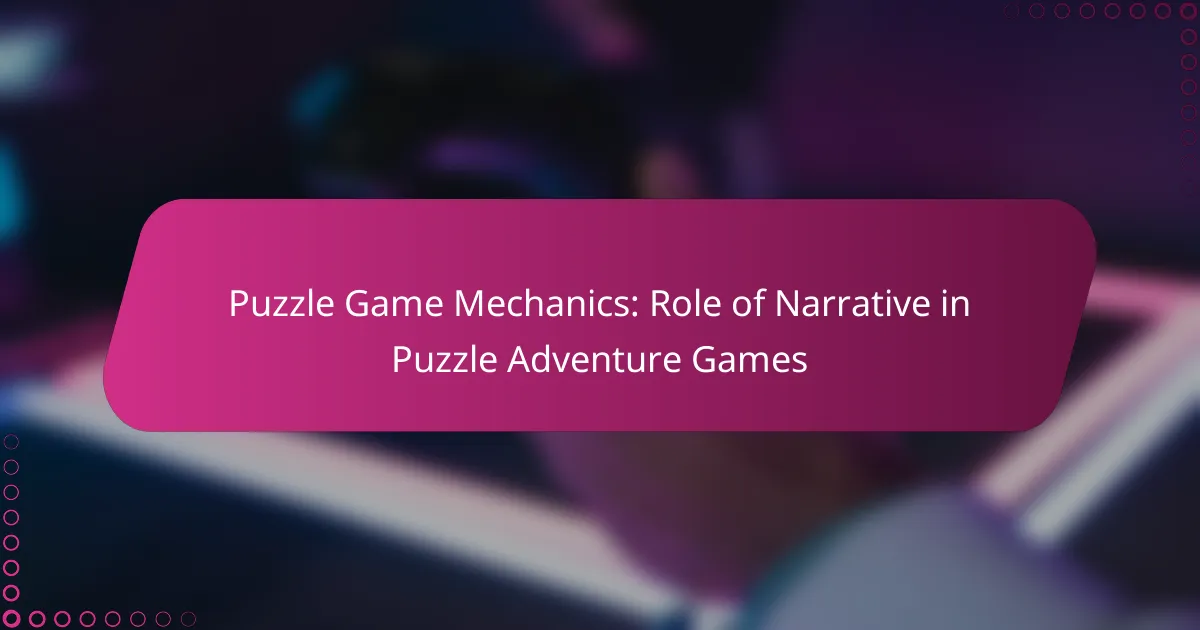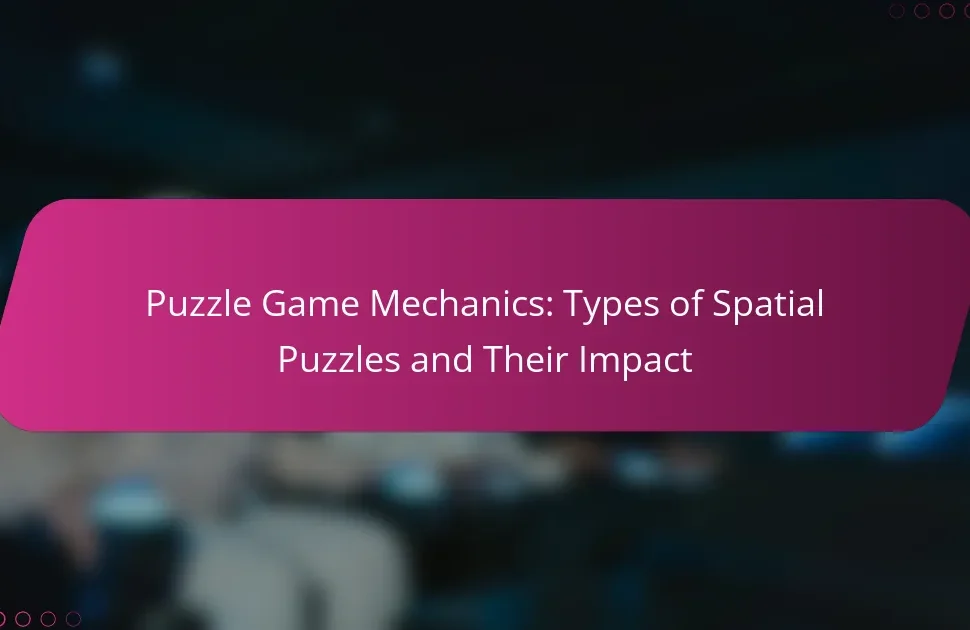Narrative elements play a crucial role in enhancing player engagement in puzzle adventure games. They provide context and motivation, create emotional depth, and guide puzzle design. Environmental storytelling, character-driven puzzles, and narrative branching are key mechanics that deepen emotional connections. Cultural influences shape these narratives, while developers face challenges in balancing puzzles with narrative flow. Emerging trends focus on immersive storytelling, player agency, and AI-driven narratives for a personalized experience.
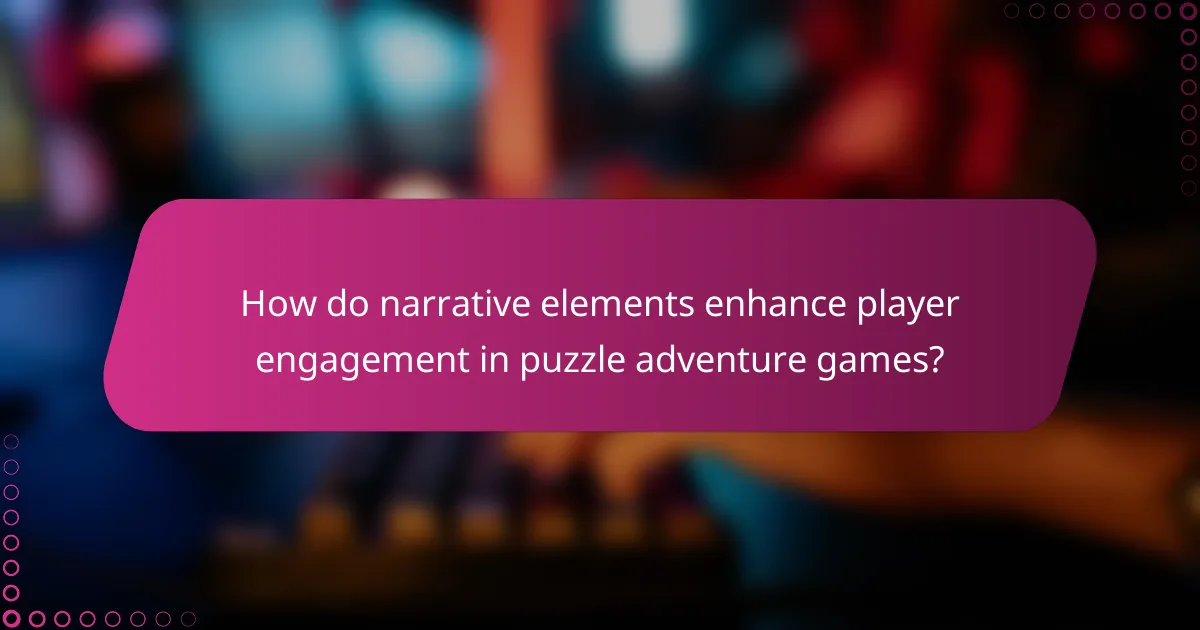
How do narrative elements enhance player engagement in puzzle adventure games?
Narrative elements significantly enhance player engagement in puzzle adventure games by providing context, motivation, and emotional depth. They create immersive experiences that encourage players to solve puzzles to progress the story. Strong narratives can lead to deeper emotional connections with characters and settings, increasing overall investment in the game. Additionally, well-integrated storylines can guide puzzle design, ensuring challenges align with thematic elements, which enhances player satisfaction and retention.
What are the key narrative techniques used in puzzle adventure games?
Puzzle adventure games utilize various narrative techniques to enhance player engagement and immersion. Key techniques include environmental storytelling, character development, and plot twists. Environmental storytelling allows players to piece together narratives through their surroundings, while character development deepens emotional investment. Plot twists maintain suspense and challenge players’ assumptions, enriching the overall experience.
Why is character development important in puzzle game narratives?
Character development is crucial in puzzle game narratives as it enhances player engagement and emotional investment. Well-developed characters provide context and motivation for solving puzzles, making the gameplay experience more immersive. This depth allows players to connect with the storyline, increasing their commitment to overcoming challenges. Furthermore, unique character attributes can introduce varied puzzle mechanics, enriching the gameplay. Ultimately, strong character narratives contribute to a more compelling and memorable puzzle adventure.
How does the setting influence puzzle design and narrative integration?
The setting significantly influences puzzle design and narrative integration by shaping player immersion and contextual relevance. A well-crafted environment enhances the thematic elements of puzzles, making them feel integral to the story. For example, a mysterious forest may host riddles that reflect its lore, while a futuristic city could present tech-based challenges.
Moreover, the setting can dictate the type of puzzles players encounter. A historical setting might feature logic puzzles based on ancient artifacts, while a sci-fi backdrop could involve spatial reasoning with advanced technology. This alignment fosters a cohesive experience where players feel their problem-solving efforts contribute to narrative progression.
Additionally, unique attributes of the setting, such as ambiance and cultural elements, can introduce rare puzzle mechanics that enhance engagement. For instance, puzzles that require players to interact with the environment in innovative ways can deepen the narrative connection, allowing players to uncover story elements through gameplay.
In summary, the setting is a crucial component that not only informs puzzle mechanics but also enriches the narrative experience, creating a more immersive adventure for players.
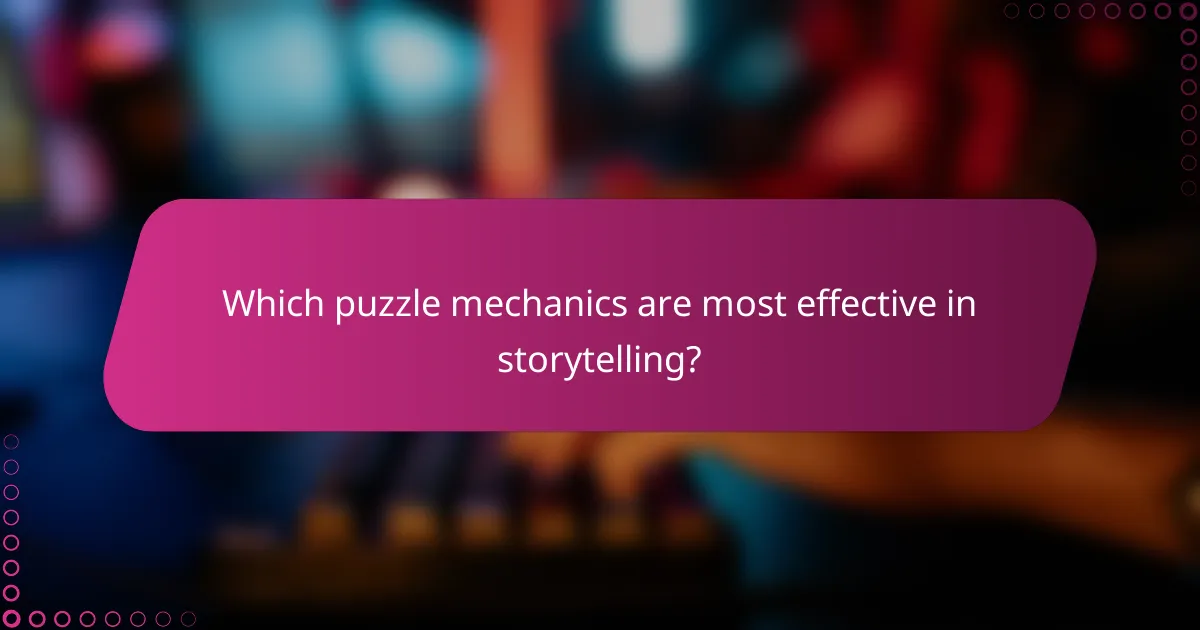
Which puzzle mechanics are most effective in storytelling?
Puzzle mechanics that integrate narrative elements effectively enhance player engagement and emotional investment. These mechanics include environmental storytelling, character-driven puzzles, and narrative branching. Environmental storytelling immerses players in the game world, using visuals and context to convey the story. Character-driven puzzles connect players to characters, making their actions and decisions feel meaningful. Narrative branching allows players to influence the story, creating a personalized experience that deepens their connection to the narrative. These mechanics work together to create a cohesive and compelling storytelling experience in puzzle adventure games.
How do environmental puzzles contribute to narrative immersion?
Environmental puzzles enhance narrative immersion by integrating gameplay with story elements. They create a seamless experience, allowing players to engage with the plot through problem-solving. This interaction deepens emotional investment, as players feel their actions influence the narrative. Unique attributes of environmental puzzles, such as context-specific clues, further enrich storytelling. As a result, players experience a more compelling and interactive journey.
What role do dialogue and text play in advancing the story?
Dialogue and text are crucial for advancing the story in puzzle adventure games. They provide context, enhance character development, and guide players through the narrative. Engaging dialogue motivates players to solve puzzles and unlock the story’s progression. Textual elements, such as hints or lore, deepen immersion and enrich the gaming experience. Together, these components create a cohesive narrative that intertwines with gameplay, making the story an integral part of the puzzle-solving journey.

What are the psychological impacts of narrative-driven puzzles on players?
Narrative-driven puzzles positively impact players’ psychological well-being. They enhance engagement, foster emotional connections, and promote problem-solving skills. Players often experience a sense of accomplishment and immersion, leading to improved cognitive function and stress relief. The storytelling aspect can also evoke empathy, enriching the overall gaming experience.
How does emotional storytelling affect player satisfaction?
Emotional storytelling significantly enhances player satisfaction in puzzle adventure games by creating a deeper connection to the narrative. Players engage more fully when they relate to characters and storylines, resulting in increased immersion and emotional investment. This connection can lead to a more rewarding gaming experience, as players feel their actions impact the story. Furthermore, well-crafted narratives can motivate players to solve puzzles, as they seek to uncover more of the story. Ultimately, the integration of emotional storytelling fosters a compelling gameplay experience that resonates with players on multiple levels.
Why do players prefer certain narrative styles in puzzle games?
Players prefer certain narrative styles in puzzle games because they enhance immersion and engagement. Narrative styles that evoke emotion or curiosity encourage players to invest time and effort into solving puzzles. For instance, stories that unfold gradually can create a sense of discovery, making each puzzle feel more rewarding.
Additionally, narrative-driven puzzles often incorporate unique attributes, such as character development or world-building, which can deepen player attachment. Players may gravitate toward narratives that resonate with their personal experiences or preferences, leading to varied preferences across the gaming community.
Overall, the interplay of narrative and puzzle mechanics significantly influences player choices, enhancing the overall gaming experience.
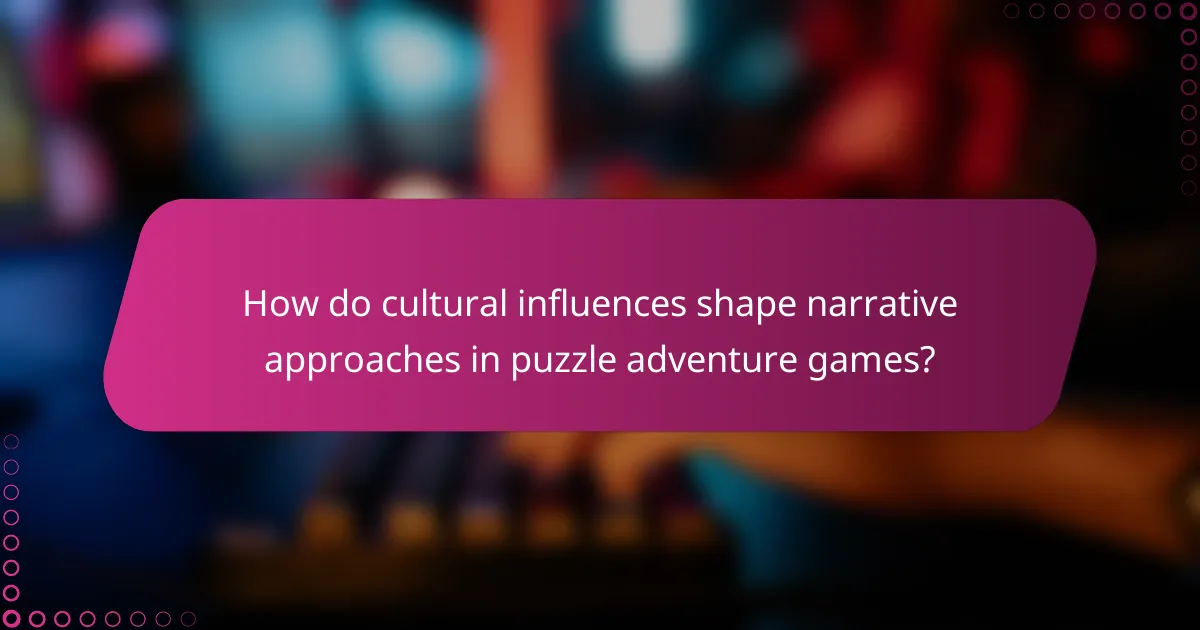
How do cultural influences shape narrative approaches in puzzle adventure games?
Cultural influences significantly shape narrative approaches in puzzle adventure games by integrating themes, storytelling techniques, and character development unique to specific cultures. These narratives often reflect societal values and historical contexts, enhancing player engagement. For example, Japanese puzzle games may emphasize harmony and nature, while Western games might focus on individualism and conflict resolution. The incorporation of cultural elements creates a richer gaming experience, allowing players to explore diverse perspectives and problem-solving methods. Ultimately, these narratives not only serve as a backdrop but also influence gameplay mechanics, guiding players through culturally resonant challenges.
What unique narrative elements are found in regional puzzle games?
Regional puzzle games often incorporate unique narrative elements that enhance player engagement. These narratives typically reflect local culture, folklore, or history, providing context for the puzzles. Character development is often tied to regional identities, making the gameplay more relatable. Additionally, the integration of language and dialect can create an immersive experience. Environmental storytelling, where the setting conveys a narrative, is also prevalent, enriching the player’s journey through the game. These elements collectively contribute to a distinctive gaming experience that resonates with regional audiences.
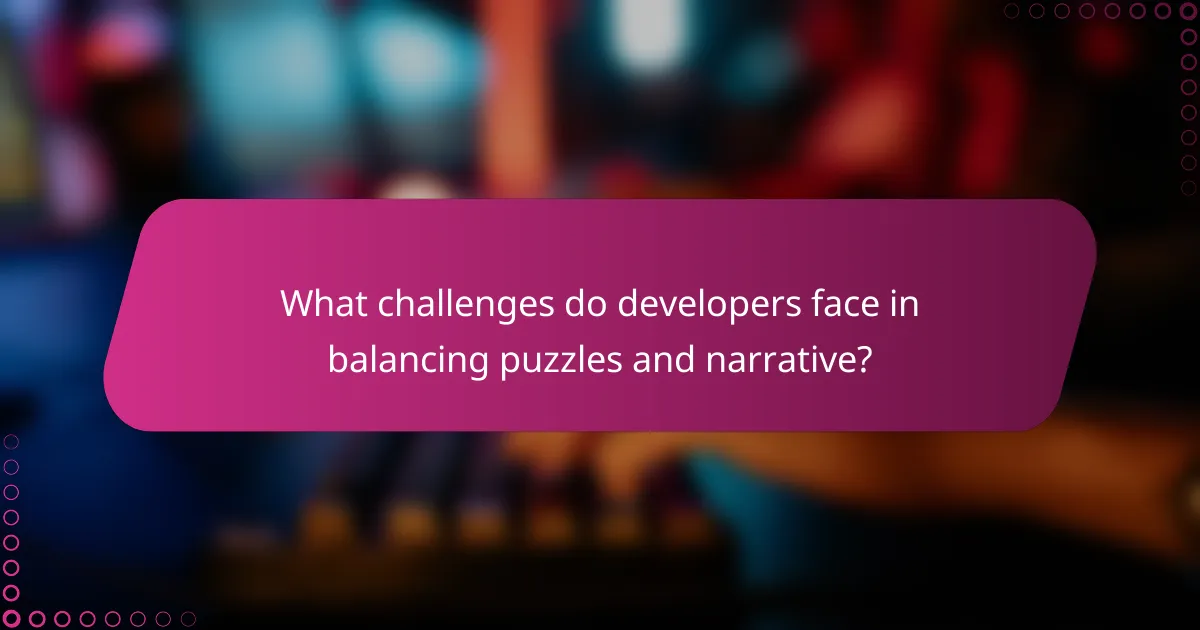
What challenges do developers face in balancing puzzles and narrative?
Developers face challenges in balancing puzzles and narrative due to the need for coherence and engagement. Puzzles must seamlessly integrate into the story, enhancing rather than disrupting the narrative flow. Additionally, developers must ensure that puzzles are appropriately challenging while remaining accessible to players, which can complicate narrative pacing. The risk of frustrating players with overly complex puzzles can detract from the overall experience. Lastly, developers often struggle with ensuring that the narrative context supports puzzle design, making it relevant and meaningful within the game world.
How can narrative pacing impact puzzle difficulty and player experience?
Narrative pacing significantly influences puzzle difficulty and player experience by controlling tension and engagement. A well-paced narrative can enhance immersion, making puzzles feel more integral to the story. Conversely, poor pacing may lead to frustration, as players struggle to connect narrative elements with puzzle-solving.
Effective pacing allows players to absorb clues and context, fostering a sense of accomplishment. When narrative and puzzles align, players experience a rewarding flow, enhancing enjoyment. In contrast, abrupt shifts can disrupt this flow, increasing perceived difficulty.
Balancing narrative progression with puzzle complexity is crucial. Gradually increasing difficulty can maintain player interest while ensuring challenges remain engaging. This balance ultimately shapes the overall gaming experience, impacting player retention and satisfaction.
What common pitfalls should developers avoid when integrating narrative with puzzles?
Developers should avoid disjointed storytelling, overcomplicated puzzles, and neglecting player feedback when integrating narrative with puzzles. These pitfalls can disrupt immersion and frustrate players. Ensuring narrative elements enhance rather than hinder puzzle mechanics is crucial for a cohesive experience. Balancing complexity with clarity is essential to maintain engagement and satisfaction.
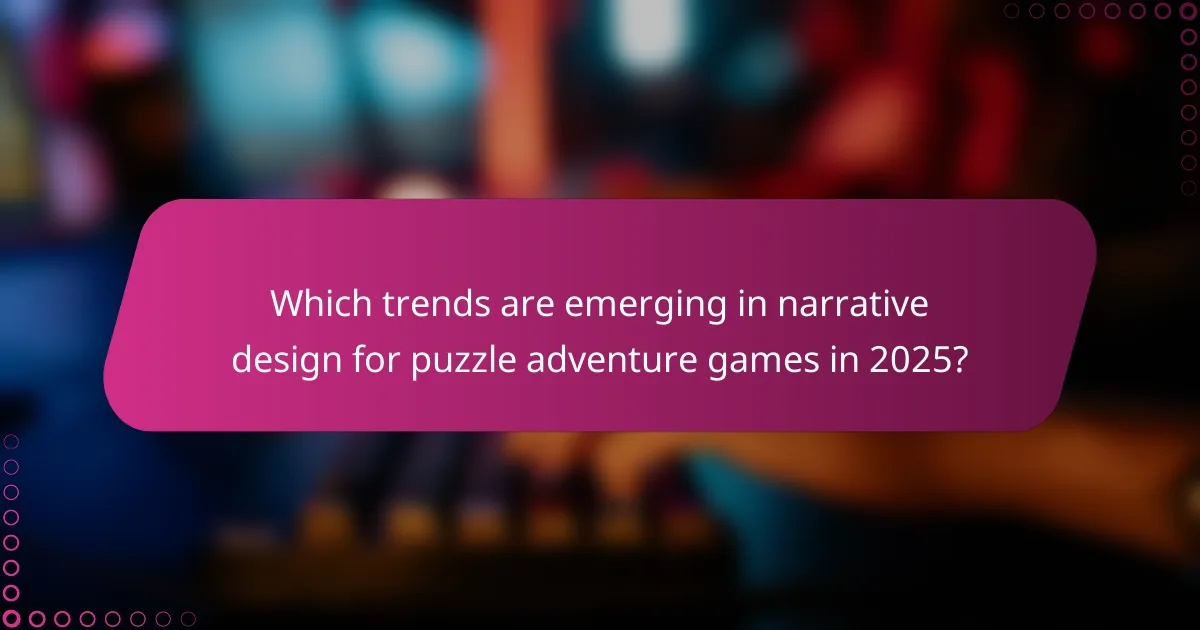
Which trends are emerging in narrative design for puzzle adventure games in 2025?
Emerging trends in narrative design for puzzle adventure games in 2025 focus on immersive storytelling and player agency. Games increasingly integrate dynamic narratives that adapt to player choices, enhancing engagement and replayability.
Another trend is the incorporation of interactive environments that respond to narrative developments, creating a seamless blend of puzzle-solving and storytelling. This approach deepens the player’s emotional connection to the game world.
Additionally, cross-media storytelling is gaining traction, where narratives extend beyond the game into other formats like comics or web series, enriching the overall experience.
Finally, the use of AI-driven narratives allows for personalized story arcs, making each player’s journey unique and tailored to their decisions, thus elevating the puzzle adventure genre.
How are player choices influencing narrative outcomes in modern puzzle games?
Player choices significantly shape narrative outcomes in modern puzzle games by creating branching storylines and personalized experiences. These decisions influence character development, plot progression, and the resolution of puzzles, enhancing player engagement. For instance, players may choose different paths that lead to unique endings or alter interactions with characters, making each playthrough distinct. This dynamic interaction fosters a deeper emotional connection to the game’s narrative, as choices reflect players’ values and preferences. Ultimately, the integration of player agency within puzzle mechanics enriches the storytelling aspect, making it a central feature of modern puzzle adventure games.
What innovations in storytelling are being adopted in puzzle game mechanics?
Puzzle adventure games increasingly adopt narrative-driven innovations in their mechanics. These innovations enhance player engagement by integrating story elements directly into gameplay.
One significant trend is the use of environmental storytelling, where the game world reveals plot points through visual cues and interactions. This method deepens immersion and encourages exploration.
Another innovation is character-driven puzzles, where solving challenges directly impacts character development or story progression. This creates a sense of agency and emotional investment in the narrative.
Additionally, branching narratives in puzzle mechanics allow players to make choices that affect outcomes, promoting replayability and personal connection to the story. Such approaches redefine how narratives and puzzles intertwine, elevating the overall gaming experience.
What best practices should developers follow for effective narrative integration?
Developers should prioritize seamless narrative integration to enhance player engagement in puzzle adventure games. Focus on aligning puzzles with the storyline, ensuring that each challenge contributes to character development or plot progression.
Incorporate environmental storytelling, where the game world itself reveals narrative elements through design and clues. This approach deepens immersion and creates a cohesive experience. Use character dialogue and interactions to provide context for puzzles, making them feel relevant to the narrative.
Maintain a balance between challenge and story; puzzles should not disrupt the flow of the narrative. Test narrative pacing to ensure that players remain engaged without feeling overwhelmed. Lastly, gather player feedback to refine narrative elements, adapting them to enhance overall gameplay experience.
